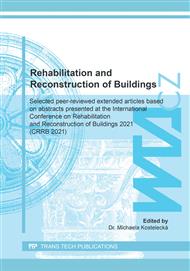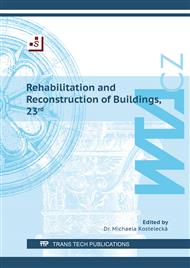p.3
p.9
p.15
p.23
p.31
p.39
p.45
p.55
Long-Term Monitoring Side Chapel Church from the Point of View of Formation and Course of Condensation on its Inner Surface
Abstract:
The article deals with church microclimate monitoring and describes microclimatic changes within one year. The monitoring period was the year 2020. Based on the results of long-term monitoring and taking into account the temperature of the inner surface temperature of masonry was executed simulation in 2D software to analyze surface temperature according to the agency of moisture on the surface of the perimeter wall. Attention was targeted to the determination of the period to the occurrence of adverse events (condensation of water vapor and occurrence of mild).
Info:
Periodical:
Pages:
23-28
Citation:
Online since:
September 2022
Authors:
Price:
Сopyright:
© 2022 Trans Tech Publications Ltd. All Rights Reserved
Share:
Citation:



